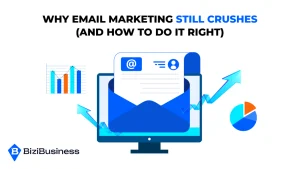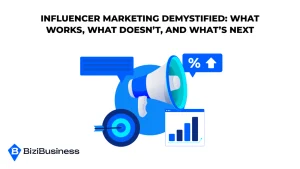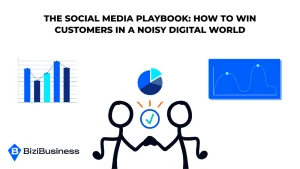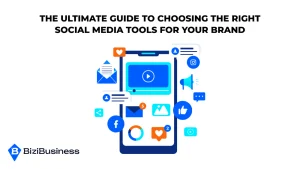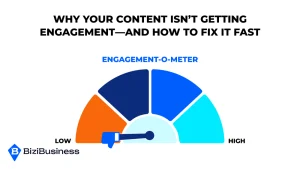BiziTopics
Why Product Videos Beat Product Descriptions (Every Time)
BiziBusiness
Jul 8, 2025
16 min read
You’ve got a great product.
You wrote the perfect description.
You hit publish… and then?
Crickets.
Because in today’s e-commerce world, text alone doesn’t cut it.
People don’t want to read about your product—they want to see it in action.
They want to know how it looks, how it works, and what it feels like in real life.
They want proof. Clarity. Confidence.
And they want it fast.
Enter: product videos—the game-changing, conversion-boosting content format that’s leaving static product descriptions in the dust.
In this article, we’re breaking down why video wins every time—and how smart e-commerce brands use it to boost engagement, reduce returns, and close more sales without saying a word.
The Scroll-Stopping Truth: Text Alone Doesn’t Sell Anymore
Let’s face it—today’s online shoppers don’t read, they scroll.
Fast. Distracted. Multitasking.
They’re bombarded with content all day, every day—and your carefully written product description? It barely stands a chance.
You have 3–5 seconds to capture attention before they move on.
And here’s the kicker:
Even if your description is beautifully written, informative, and keyword-optimized… it’s still just words on a screen.
That’s not how most people want to shop anymore.
The Modern Brain Is Trained for Video
Thanks to platforms like TikTok, Instagram Reels, and YouTube Shorts, consumers have been conditioned to expect:
- Visuals first
- Movement over text
- Instant understanding of what a product does or solves
When someone’s deciding whether to buy your product, they don’t want to imagine how it works.
They want to see it.
The Static Description Problem
Product descriptions might tell a story—but they rarely show one.
That gap between what customers read and what they visualize?
That’s where hesitation lives.
And hesitation kills conversions.
If your competitors are showing their product in use—and you’re just writing about it—you’ve already lost the sale.
The Shift Is Here
Brands that adapt to video aren’t “early adopters” anymore—they’re the new standard.
Because in a feed full of visuals and movement, a product video grabs attention and keeps shoppers engaged long enough to make a decision.
Next up, let’s break down why video taps into the psychology of trust, emotion, and action—and why it works so much better than static text.
The Psychology of Seeing vs. Reading

When it comes to selling online, the real competition isn’t price or product—it’s attention and trust.
And in a digital world drowning in content, video cuts through faster, deeper, and more effectively than text ever could.
Why? Because it’s hardwired into how we’re built as humans.
The Brain Loves Visuals
Our brains are visual-first by design. In fact:
- 90% of information transmitted to the brain is visual
- We retain 95% of a video’s message, compared to only 10% when reading it in text
- The average person can process visual information in just 13 milliseconds
That means a shopper can watch a 10-second video and immediately understand:
- How big your product is
- What it looks like from every angle
- How it works in real life
Whereas a product description might take 2–3 paragraphs to try to do the same—and still leave them unsure.
Show It, Don’t Say It
Let’s say you sell a self-cleaning water bottle.
A description might say:
“This innovative bottle uses UV-C technology to kill 99.99% of bacteria with a single tap.”
A video could show someone pressing the cap, seeing the glow, and confidently drinking clean water—while hiking a mountain.
Which one sticks?
Which one sells?
The brain believes what it sees far more than what it reads.
Video = Emotion + Empathy + Experience
The buying decision is emotional long before it’s rational.
That’s why:
- Seeing a mom use your baby product = trust
- Watching a person with your backpack in the wild = aspiration
- Hearing a customer rave about their results = belief
Video creates micro emotional moments that text simply can’t match.
These feelings lead to connection.
Connection builds confidence.
Confidence drives clicks.
Mirror Neurons and Buyer Imagination
When someone sees your product being used, mirror neurons in their brain fire off. It’s as if they’re experiencing it themselves.
So when they watch someone try on your skincare, sip your coffee, or work out in your gear, their brain starts thinking:
“That could be me.”
“I want that experience.”
“This looks easy… I trust it.”
You don’t have to convince them anymore—they’re already sold.
Clarity Builds Trust—and Trust Closes Sales
Uncertainty is the #1 silent killer of online conversions.
Text alone often leaves customers with questions like:
- “Will it fit me?”
- “Is the color really like that?”
- “How does it actually work?”
- “What does it sound like / feel like / move like?”
Video answers those questions before they’re even asked.
And when questions disappear, hesitation does too.
No hesitation = more conversions.
Text vs. Video: What’s Built for the Brain
| Text | Video |
|---|---|
| Slower to process | Instantly understood |
| Relies on imagination | Shows the real thing |
| Explains | Demonstrates |
| May confuse | Clarifies |
| Tells | Sells |
If you’re relying solely on text to do the heavy lifting, you’re asking your audience to work too hard.
Video makes it easy to say yes.
Where Product Descriptions Fall Short

There’s nothing wrong with having a solid product description.
But there’s a lot wrong with depending on it to do all the heavy lifting.
Because even the best-written copy has limits—and in today’s fast-paced, content-driven world, those limits are costing you customers.
Let’s break down where traditional descriptions drop the ball—and why video picks it up.
They Can’t Show the Real Product
A product description might say:
“Made from high-quality vegan leather, with a sleek, minimalist design.”
But what does that actually look like?
- Is the texture smooth or grained?
- Does it reflect light?
- How does it move or bend when used?
Without visuals, you’re asking the shopper to imagine it—and if they can’t picture it clearly, they’ll scroll on.
Video shows reality, not just promises.
They Leave Too Much to the Imagination
Descriptions often leave gaps—especially with:
- Size (Is it as big as a phone? A laptop?)
- Functionality (How do the buttons work? Is it easy to use?)
- Fit (Does it look good on different body types?)
- Assembly/setup (Is it simple or frustrating?)
And guess what?
Confusion = hesitation.
Hesitation = lost sale.
They Struggle to Build Trust
Anyone can write “premium quality” or “best-in-class.”
But saying it doesn’t make it believable.
Video builds trust by showing:
- Real use in real environments
- Happy customers using your product
- Details and textures that photos and words can’t fully capture
- Faces, voices, and movement—which feel authentic
When shoppers see it, they believe it.
And belief leads to buying.
They Lack Energy and Emotion
Text is logical. But logic doesn’t sell—emotion does.
Product descriptions:
- Don’t show excitement or expression
- Don’t demonstrate satisfaction or transformation
- Don’t create a “wow” moment or a smile
Video can show joy, relief, surprise, confidence—the stuff that turns shoppers into believers and brand advocates.
They Rely on Reading (and Attention is Short)
Let’s be real: most shoppers are skimming at best.
- Long blocks of text = ignored
- Bullets are good, but still limited
- Many people just scroll to the price, glance at photos, and bounce
A 15-second video that shows your product in use communicates 10x more, 10x faster.
Types of Product Videos That Actually Work

Not all videos are created equal.
Sure, video in general boosts performance—but the right type of video can dramatically amplify trust, drive urgency, and boost conversions like crazy.
Whether you’re a solo store owner with an iPhone or a brand with a creative team, here’s what to focus on:
Quick Demo / Explainer Videos (a.k.a. the MVP)
What it is: A fast, clear walkthrough of your product in use—ideally under 30 seconds.
What it does:
- Shows how the product works
- Highlights features & benefits visually
- Answers “how does this actually function?” instantly
Perfect for:
- Gadgets, tools, home goods, fitness products, tech accessories
Example:
A skincare brand shows a customer applying a serum in 3 steps, with close-ups of the texture, absorption, and results.
✅ Why it works: Demonstration = clarity = confidence = conversion.
Unboxing / “What’s in the Box” Videos
What it is: A customer or creator opens your package on camera and explores everything inside.
What it does:
- Builds anticipation and excitement
- Highlights packaging, quality, extras
- Sets clear expectations and shows care
Perfect for:
- Subscription boxes, premium products, giftable items, electronics
Example:
A tech influencer unboxes wireless earbuds, shows accessories, peels off stickers, and gives a first-impression reaction.
✅ Why it works: Adds transparency, creates a tactile experience online, and boosts perceived value.
Lifestyle Use-Case Videos
What it is: Your product shown in real-life environments, being used as your customer would actually use it.
What it does:
- Connects emotionally with the viewer’s lifestyle or identity
- Demonstrates versatility
- Helps shoppers visualize themselves with the product
Perfect for:
- Apparel, outdoor gear, home decor, kitchen tools, fitness equipment
Example:
A water bottle shown during a hike, in a gym bag, and on a desk—highlighting different lifestyle use cases in one clip.
✅ Why it works: It’s storytelling through context. People want to see themselves using what you sell.
UGC (User-Generated Content) / Testimonial Videos
What it is: Real people, real opinions—often shot on a phone, raw and authentic.
What it does:
- Adds social proof and relatability
- Reduces friction with “people like me” validation
- Builds trust without sounding salesy
Perfect for:
- Any product with happy customers
Example:
A customer films themselves saying, “I’ve been using this face cream for 3 weeks and my skin has never felt better.”
✅ Why it works: Buyers trust buyers. UGC feels real—and real always outperforms polished.
FAQ / Objection-Busting Videos
What it is: A short clip answering the top 2–3 concerns customers have before buying.
What it does:
- Handles hesitation before it happens
- Speeds up the buying decision
- Positions you as helpful and transparent
Perfect for:
- Products with a learning curve, premium pricing, or common buyer questions
Example:
A mattress brand does a 60-second “Common Questions” video: “Is it firm?” “Does it get hot?” “How does shipping work?”
✅ Why it works: When you answer questions proactively, you reduce bounce and increase confidence.
BONUS: Hybrid Videos (The Converting Combo)
What it is: A mix of multiple video types in one powerful sequence.
Example:
- 5-sec hook with lifestyle shot
- Quick demo of key feature
- Overlayed quote from a real review
- Ends with CTA + logo
Why it works: You pack emotional appeal, clarity, and proof into one fast-moving format—perfect for ads, social, and product pages.
The goal isn’t to make Hollywood-level videos—it’s to connect, clarify, and convert.
Even simple, authentic clips shot on your phone can outperform the fanciest description or static photo.
Next up: Let’s talk about how to actually make these videos—even without fancy gear.
How to Make High-Converting Videos (Without a Studio)

Think you need a film crew, studio lights, or a $10k production budget to create product videos that convert?
Think again.
Some of the highest-performing videos in e-commerce are filmed with nothing more than:
- A smartphone
- Natural light
- A steady hand (or $20 tripod)
The key isn’t production value—it’s strategy, clarity, and relatability.
Here’s how to create scroll-stopping, sales-driving videos with the tools you already have.
Use What You Have (Your Phone Is Enough)
Modern smartphones shoot in 4K. That’s more than enough.
✅ Use the back camera for higher quality
✅ Shoot in natural light near a window
✅ Wipe your lens before filming (seriously—it makes a huge difference)
Optional upgrades:
- A tripod for stability
- A small ring light if filming indoors
- A clean, neutral background (white poster board works great)
Script the Story, Not the Lines
You don’t need a full screenplay—you need a structure.
Here’s a simple 3-part video script format that works every time:
- Hook (0–3 seconds): Grab attention. Pose a question, show the product in action, or highlight a key benefit.
- “Struggling to find the perfect everyday bag?”
- [Quick shot of bag being opened, packed, and zipped]
- Value (4–20 seconds): Demo the product. Focus on what it solves, not just what it is.
- Show features with captions
- Use voiceover or ambient sound
- Keep it fast-paced and visual
- Call to Action (final 3–5 seconds): Tell viewers what to do next.
- “Tap to shop now”
- “See why 10,000+ customers love it”
Tip: Keep your videos under 30 seconds unless it’s a deep-dive (like a testimonial or tutorial).
Format for Where It’s Going
Product page video and Instagram Reels shouldn’t look the same. Optimize for platform:
| Platform | Format | Key Notes |
|---|---|---|
| PDP (Product Page) | Landscape or square | Clean, brand-aligned |
| Instagram / TikTok | Vertical (9:16) | Text overlays + captions |
| Ads | Fast-paced, high hook | CTA upfront |
| Short (10–15s), looping GIF or embedded video | Focus on product benefit | |
| YouTube | Longer, horizontal | Ideal for explainer or review style |
Always include captions—most people watch with sound off.
Edit With Free or Low-Cost Tools
No need for Final Cut Pro. These tools get the job done:
- CapCut (free, mobile-friendly, perfect for TikTok-style edits)
- InShot (great for quick edits + text overlays)
- Canva Video (for branded elements + simple transitions)
- iMovie (if you’re on Mac)
✅ Add branding, simple transitions, and your CTA
✅ Include subtitles for accessibility
✅ Keep it fast-paced—cut the fluff
Don’t Be Perfect—Be Relatable
Your customers aren’t expecting a Super Bowl commercial.
They want:
- Real people using real products
- Videos that look like someone they follow, not a brand trying to sell them something
- Content that feels authentic, not overly produced
That’s why UGC-style videos often outperform brand videos—because they feel more trustworthy.
Bonus: Repurpose Everything
One video shoot = content for:
- PDP
- Instagram Reel
- TikTok
- Facebook ad
- Email campaign
- Story highlight
- Blog embed
You don’t need 10 videos. You need one good video, used 10 different ways.
Where to Use Product Videos for Maximum ROI
You’ve created a killer product video—now what?
Too many brands make a great video and only upload it to one place (usually the product page) and call it a day.
Big mistake.
Because a single, well-made product video can fuel your entire marketing engine—if you know where to put it.
Here’s how to turn one video into multiple revenue-generating touchpoints.
Product Pages (PDPs)
This is non-negotiable.
Embedding a video directly on your product page gives shoppers instant clarity—and keeps them on the page longer.
Why it works:
- Reduces bounce
- Answers key questions
- Gives visual proof that complements your photos & description
How to use it:
- Position the video near the “Add to Cart” button or above the fold
- Use a thumbnail with a play button to increase clicks
- If possible, use autoplay (muted) to grab attention instantly
Social Media (Instagram, TikTok, Facebook)
Social platforms are made for video. This is where your product can go viral—or at least reach a much larger audience.
Why it works:
- Video gets higher engagement, saves, and shares
- Native platforms push video over static content in their algorithms
- Builds brand visibility and familiarity
How to use it:
- Share your demo or lifestyle video as a Reel or TikTok
- Add UGC clips for authenticity
- Use trending audio + branded captions to catch attention
- Always include a CTA (“Shop now in bio”) in the caption or video
Paid Ads (Meta, TikTok, YouTube, Google)
A strong product video can dramatically reduce ad costs and increase conversions—especially in remarketing campaigns.
Why it works:
- Stops scroll in high-noise environments
- Tells your product story in seconds
- Performs well across all stages of the funnel
How to use it:
- Use 15–30 sec cuts in Facebook/Instagram ads
- Run UGC-style videos for cold audiences
- Use FAQ or demo-style videos for retargeting warm leads
- Test different CTAs and intros to optimize results
Email Marketing
Most brands are sleeping on video in email—and leaving engagement on the table.
Why it works:
- Makes your emails more dynamic
- Boosts click-through rate
- Re-engages subscribers who are skimming
How to use it:
- Embed video (or GIF preview) in product launch emails
- Add video testimonials in post-purchase flows
- Include video tutorials in onboarding or education sequences
Homepage & Landing Pages
Think beyond the product page—your homepage or campaign landing page is prime video territory.
Why it works:
- Sets the tone for first-time visitors
- Quickly communicates product value
- Increases dwell time = better SEO + conversions
How to use it:
- Add a video hero banner with autoplay (muted)
- Feature lifestyle videos to tell your brand story
- Use video to support lead capture offers or bundles
Amazon & Marketplace Listings
If you’re on Amazon or any marketplace that allows video—you need to be using it. Listings with videos convert 80% higher on average on Amazon.
Why it works:
- Builds trust fast in a competitive, noisy environment
- Answers shopper questions immediately
- Sets you apart from static-only competitors
How to use it:
- Add product demo and explainer videos to listings
- Use customer testimonial videos for social proof
- Optimize video length and thumbnail for mobile-first shoppers
One video can multiply your reach and revenue when used strategically.
It’s not just about making the video—it’s about distributing it everywhere your customers are.
The Future of E-Commerce is Visual
In an online world full of distractions, static text simply isn’t enough to convert curious visitors into confident buyers.
Product videos don’t just enhance your store—they elevate the entire customer experience. They show, rather than tell. They build trust at speed. They reduce uncertainty and create emotional connection—two things no paragraph can do on its own.
Whether it’s a simple demo, a real-life testimonial, or a lifestyle clip that sparks desire, video turns your product from a concept into something tangible and irresistible.
And you don’t need expensive equipment or a film crew.
You just need a clear message, a mobile camera, and the commitment to start showing your product the way your customers want to see it.
So if you’re ready to increase conversions, reduce returns, and outpace competitors—video isn’t optional anymore.
It’s essential.
In e-commerce, seeing truly is believing.
And believing leads to buying.
Subscribe to Newsletter
Unlock your creativity and stay up to date on marketing tips
